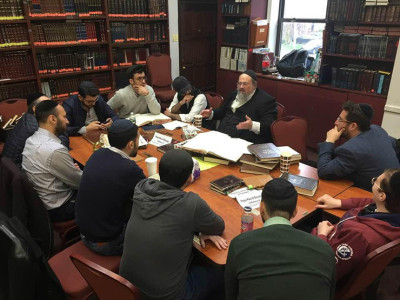
Based on their shiurim of Rav Aharon Walkin ztk”l delivered at the Chazaq Beit Midrash Bais Nosson Meir / Kollel Zichron Moshe V’Leah
Kabbalat HaTorah Is Yom Kippur
Why do we celebrate the anniversary of kabbalat haTorah on Shavuot, if afterwards we “ruined it” by serving the eigel? Why don’t we celebrate the anniversary of the second kabbalat haTorah, which is Yom Kippur?
The real simchah is that we stated na’aseh v’nishmah, at the first kabbalat haTorah, and that remained, despite the Jewish people creating the eigel. Na’aseh v’nishmah is our ratzon, desire for Torah, that cannot be extinguished. Dovid Hamelech in Shir HaShirim (8:7) describes how love can not be tarnished, as it says, “Vast floods cannot quench love, nor rivers drown it. If a man offered all his wealth for love, he would be laughed at and scorned.”
No matter what the situation is in a relationship, there is love. No matter what is thrown at someone, that relationship cannot be tarnished. Moreover, this portrayal of love to Hashem is what we are celebrating on the yom tov of Shavuot. The fact that we created the eigel goes to show that no matter what transpired during the course of klal Yisrael’s history, the spark of na’aseh v’nishmah will never be destroyed. Remember, the Jewish nation rose to accept the second luchot.
The Mesirat Nefesh For Torah:
Rav Shmuel WalkinMy grandmother, Rebbetzin Walkin, a’’h, told the family how she fled from the Nazis on Shavuot. As the story went, my grandmother was by the side of my great-grandfather who was a respected rav in a shtetl near the city of Radin. On Shavuot night there was a knock on the door informing the family that they were to depart for Siberia the following day. My great-grandfather awoke my grandmother explaining that he had hired a Polish driver to help her flee before daybreak. Her father gave her his boots as a means to stay safe and warm, and moreover as a parting gift, knowing all too well that they would likely never see one another again as my grandfather refused to abandon his beloved followers. Despite a bad snowstorm, the Polish man brought my grandmother, her three children, and her own grandmother’s leichter to the outskirts of their town. May the strength of Torah keep us all united.
The Mesirat Nefesh For Torah:
The Beit AharonWhen I was a bochur in Mir yeshivah, I would regularly walk through the Bukharian neighborhood. One day, an old Bukharian Jewish man summoned me to his side. As it turned out, this man was none other than Rav Yosef Cohen, ztk’’l, a son-in-law of Rav Tzvi Pesach Frank, and av beit din of Yerushalayim. Rav Cohen sought my help in transporting his beloved wife from her bed to a wheelchair. After hearing my name, Rav Cohen invited me to join him at shul the following morning at 6 a.m. for Shacharit. I arrived early, thinking I would be completing a minyan. However, I was there to be introduced to a professor at Hebrew University. Upon hearing my name, the educator’s demeanor changed completely as he became visibly moved. “Rav Aharon Walkin was my rav,” he exclaimed. “I’m from Pinsk, and I was the last person to see Rav Walkin alive.”
My grandfather went into hiding six months prior to the Nazis arrival knowing that he would be a prime target. After a few months, they decreed a closure of all shuls. My grandfather came out of hiding and gathered bochurim to sign that they would continue davening with a minyan, even if it meant risking their lives. This professor was one of those bochurim. My grandfather pleaded with the young gentleman to join the movement, despite his mother’s persistent attempts at dissuading her son fearing the risk and danger. My grandfather burst into tears, finally convincing the young man to sign the petition and become a member of the resistance. This professor learned, and davened with my grandfather, until the final day when they whisked away my grandfather. This episode depicts how a Yid will always respond to ahavat haTorah.
On Shavuot, we remember how our grandfathers and grandmothers were moser nefesh. It is the belief in na’aseh v’nishmah that will bring us to the true ahavah of, “We will do and we will hear, all for one and one for all.”
For more shiurim by the Rosh HaYeshiva ztk”l, visit www.ravahronwalkin.com, or reach out to This email address is being protected from spambots. You need JavaScript enabled to view it..
Shiurei Lev Aharon - The Legacy of the Rosh HaYeshiva: HaGaon HaRav Aharon Walkin Ztk”l
Typography
- Smaller Small Medium Big Bigger
- Default Helvetica Segoe Georgia Times
- Reading Mode












